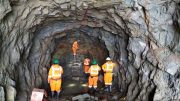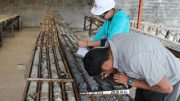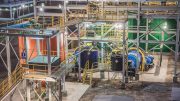Antioquia Gold (TSXV: AGD; US-OTC: AGDFX) recently published a positive National Instrument 43-101 compliant preliminary economic assessment (PEA) and a revised resource estimate for its high-grade Cisneros gold project in Colombia. Now the company is hunting for the cash to reach production.
The Northern Miner visited the 58 sq. km Cisneros project — 55 km northeast of Medellin — in late 2016. At that point the company looked poised to enter production in late 2017. Now the PEA says production is targeted for the next quarter.
The fully permitted Cisneros project holds 729,000 measured and indicated tonnes grading 5.39 grams gold per tonne for 122,000 oz. gold, plus 536,000 inferred tonnes running 6.35 grams gold per tonne for 109,400 oz. gold.
The updated estimate is based on results from 110 drill holes, including 14 new holes drilled in 2016 and 2017, and 1,130 channel samples over that span. The study used London gold and silver average prices from the previous six months.
The mineralized structures that were updated with new data include: Nus, Guaico, Footwall-3, Footwall-5, Vega and La Manuela-1. The resources for Guayabito North and Papi remain unchanged from the estimate published in 2013.
The Guaico and Guayabito veins would be mined by mechanized cut-and-fill methods, whereas the Nus structures would see long, open stoping. The processing plant would operate 347 days a year and treat 500 tonnes daily.

A development ramp into the Manuela gold zone at the Guaico deposit on the Cisneros property in Colombia. Photo by John Cumming.
Mined ounces would increase to 39,000 in 2019 from 28,000 oz. in 2018, and decrease gradually for the remaining mine life. Gold would be recovered as free gold and in concentrate.
The PEA says Cisneros has a US$23.7-million, pre-tax net present value and an 18.7% post-tax, internal rate of return (using a 5% discount rate). Project payback would take 2.6 years on a pre-tax basis.
The tricky part is that the PEA also says Antioquia Gold needs US$75.5 million to put all its ducks in a row. That includes US$61.5 million in pre-production capital costs (up from the US$40 million estimated in internal economic studies), US$14 million in sustaining capital and a 15% contingency.
But that’s less than it could have been. Antioquia Gold’s main access ramp at Guaico is already over 1,000 metres long and spirals down more than 110 metres from the mine portal. There is also a raised ventilation shaft, and Cisneros is just off a highway.
Antioquia trades at 6¢ and has 306,786,920 shares outstanding for an $18.4-million market capitalization.
The company recently withdrew a prospectus tied to a proposed rights offering in August 2017 that would have seen Antioquia raise as much as $62.5 million.
At press time, Antioquia Gold management had not responded to requests for comment.
But Antioquia Gold isn’t hunting alone. Lima-based shareholder Infinita Prosperidad Minera S.A.C. — a privately held mining company once known as Desafio Minero — owns 70% of Antioquia Gold, or 215 million shares.
Infinita has extensive gold-mining experience in Peru, which has given it the confidence to sign off on Antioquia Gold’s unorthodox plan to build a mine without a feasibility study.
But Infinita is unlikely to provide all the capital needed to reach production.
Antioquia Department
Antioquia Gold is one of a dozen companies operating in Antioquia Department, which is easily the country’s most prolific gold-producing region.
Colombia’s National Mine Agency says the country produced almost 2 million oz. gold in 2016 worth US$1.55 billion — about three-quarters of which was exported. This placed Colombia in fifteenth place among the world’s gold-producing countries.
The Colombian government typically charges companies a 4% royalty on the production value of both gold and silver, but miners can negotiate a lower rate if they meet certain conditions.
Royalty payments from gold exports added more than US$71 million to Colombian government coffers in 2016, and government officials expect that number will grow once Continental Gold’s (TSX: CNL) high-grade Buritica project — also in Antioquia Department — enters commercial production in 2020.
Continental will pay a 3.2% royalty on production.
At US$1,200 oz. gold and US$15 oz. silver, Buritica has proven and probable reserves of 13.7 million tonnes grading 8.4 grams per tonne gold and 24.3 grams per tonne silver for a total of 3.71 million oz. gold and 10.7 million oz. silver.
The mine is being built at a cost of $389 million and should produce 253,000 oz. gold per year for 14 years.
Buritica is fully permitted and funded, after the junior negotiated a $275-million loan agreement with London-based Red Kite Mine Finance and welcomed a US$109-million investment by Newmont Mining (NYSE: NEM) in May 2017.
Newmont’s 19.9% stake in Continental endorses both Buritica and Colombia, but it is not the only major gold producer active there.
AngloGold Ashanti (NYSE: AU) has a 51% interest in the Gramalote gold project, 110 km northwest of Medellin. B2Gold (TSX: BTO; NYSE-AM: BTG) owns the other 49%. AngloGold also owns the massive La Colosa gold project in Tolima province. Both Gramalote and La Colosa are undergoing prefeasibility studies.
Representatives from Barrick Gold (TSX: ABX; NYSE: ABX) met at length with Colombian government officials at the recent Prospectors & Developers Association of Canada convention in Toronto.
Meanwhile, Red Eagle Mining (TSX: R) beat its Colombian rivals to production when it poured gold at the San Ramon mine in Antioquia Department in November 2016.
San Ramon is part of Red Eagle’s wholly owned Santa Rosa gold project, an intrusive-hosted, structurally controlled quartz stockwork system in the prolific Antioquia batholith, 70 km north of Medellin.
Red Eagle has provided production guidance of between 45,000 and 50,000 oz. gold in 2018 at all-in sustaining costs of US$900 per oz. gold. The company says production will bump up to 65,000 oz. gold in 2019 through 2023 at full capacity.
Not far away in Antioquia Department, Atico Mining (TSXV: ATY) owns 90% of the El Roble copper-gold mine, which has 1.87 million measured and indicated tonnes grading 3.46% copper and 2.27 grams gold per tonne. El Roble produced 20,600 lb. copper and 10,900 oz. gold in 2017 via a copper concentrate with gold credits.
Atico is drilling its land package around El Roble.
In March 2017, Iamgold (TSX: IMG; NYSE: IAG) optioned the Zancudo gold project in the Titiribi mining district of Antioquia, 27 km south of Medellin, from Gran Colombia Gold (TSX: GCM).
Iamgold can earn a 65% interest in Zancudo by spending at least US$10 million on exploration by 2023. Iamgold can acquire another 5% interest by completing a feasibility study within three years after exercising its first option. Gran Colombia is Colombia’s largest gold producer. It delivered 173,821 oz. gold in 2017, up 16% over 2016.
The Segovia operations in Antioquia Department provided the lion’s share of gold production with 148,659 oz., up 18% over 2016. This was despite a strike in July 2017 by Segovia workers who claimed they were being extorted by a Colombian paramilitary outfit known as the Urabenos. Gran Colombia says it is unaware of any extortion attempts.
— Based in Toronto, Brian Sylvester is a freelance business writer specializing in mining.






Be the first to comment on "Antioquia Gold seeks cash for Cisneros"